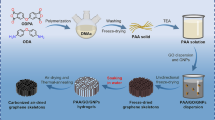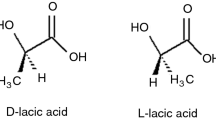Abstract
Nanocomposites of poly(ethylene glycol) (PEG) reinforced with graphene oxide (GO), prepared by drying their ultrasonically homogenized aqueous solution, were incorporated in poly(l-lactic acid) (PLLA) via melt extrusion. Raman spectroscopy revealed that the employed method increased GO’s structural defects due to exfoliation and allowed PEG to penetrate its layers. Hydrogen bonding interactions were identified in the hybrids by Fourier transform infrared spectroscopy (FTIR), whereas differential scanning calorimetry (DSC) tests showed that GO promoted PEG’s crystallization by increasing its crystallization temperature (Tc) and degree of crystallinity (Xc). The combination of nucleant and plasticizer in the hybrids increased PLLA’s Tc and melting temperature and a new band, associated with crystalline domains, appeared in their FTIR spectra. The Avrami kinetic model was implemented on DSC data to understand the isothermal crystallization behavior of PEG/PLLA blend, as well as of the system GO/PEG/PLLA. It was highlighted that GO is an effective nucleating agent for plasticized PLLA since, under the examined conditions, it enhances its crystallization rate and transforms the disk-like to sphere-like crystal formation and the two-dimensional to three-dimensional crystal growth. Furthermore, GO increased the crystallization activation energy values of plasticized PLLA due to segment transportation obstruction and transformed the double-melting peak into single after isothermal crystallization. Thermogravimetric analysis showed that GO did not enhance the heat resistivity of plasticized PLLA.










Similar content being viewed by others
References
Giita Silverajah VS, Ibrahim NA, Zainuddin N, Wan Yunus WMZ, Hassan HA. Mechanical, thermal and morphological properties of poly(lactic acid)/epoxidized palm olein blend. Molecule. 2012;17:11729–47.
Pinto AM, Gonçalves C, Gonçalves IC, Magalhães FD. Effect of biodegradation on thermo-mechanical properties and biocompatibility of poly(lactic acid)/graphene nanoplatelets composites. Eur Polym J. 2016;85:431–44.
Wojtczak E, Gadzinowski M, Makowski T, Maresz K, Kubisa P, Bednarek M, Pluta M. Encapsulation of hydrophobic vitamins by polylactide stereocomplexation and their release study. Polym Int. 2018. https://doi.org/10.1002/pi.5674.
Jandas PJ, Mohanty S, Nayak SK. Thermal properties and cold crystallization kinetics of surface-treated banana fiber (BF)-reinforced poly(lactic acid) (PLA) nanocomposites. J Therm Anal Calorim. 2013;114:1265–78.
Mallapragada SK, Narasimhan B. Infrared spectroscopy in analysis of polymer crystallinity. Encycl Anal Chem. 2006;2006:1–14. https://doi.org/10.1002/9780470027318.a2012.
Jia S, Yu D, Zhu Y, Wang Z, Chen L, Fu L. Morphology, crystallization and thermal behaviors of PLA-based composites: wonderful effects of hybrid GO/PEG via dynamic impregnating. Polymers (Basel). 2017;9:528.
Rasselet D, Ruellan A, Guinault A, Miquelard-Garnier G, Sollogoub C, Fayolle B. Oxidative degradation of polylactide (PLA) and its effects on physical and mechanical properties. Eur Polym J. 2014;50:109–16.
Aliotta L, Cinelli P, Coltelli MB, Righetti MC, Gazzano M, Lazzeri A. Effect of nucleating agents on crystallinity and properties of poly(lactic acid) (PLA). Eur Polym J. 2017;93:822–32.
Di Lorenzo ML. Crystallization behavior of poly(l-lactic acid). Eur Polym J. 2005;41:569–75.
Li Y, Li X, Xiang F, Huang T, Wang Y, Wu J, Zhou Z. Crystallization, rheological, and mechanical properties of PLLA/PEG blend with multiwalled carbon nanotubes. Polym Adv Technol. 2011;22:1959–70.
Lai WC, Liau WB, Lin TT. The effect of end groups of PEG on the crystallization behaviors of binary crystalline polymer blends PEG/PLLA. Polymer (Guildf). 2004;45:3073–80.
He X, Qiu Z. Effect of poly(ethylene adipate) with different molecular weights on the crystallization behavior and mechanical properties of biodegradable poly(l-lactide). Thermochim Acta. 2018;659:89–95.
Barkoula NM, Alcock B, Cabrera NO, Peijs T. Fatigue properties of highly oriented polypropylene tapes and all-polypropylene composites. Polym Polym Compos. 2008;16:101–13.
Liu C, Ye S, Feng J. Promoting the dispersion of graphene and crystallization of poly(lactic acid) with a freezing-dried graphene/PEG masterbatch. Compos Sci Technol. 2017;144:215–22.
Justh N, Berke B, László K, Miklós Szilágyi I. Thermal analysis of the improved Hummers’ synthesis of graphene oxide. J Therm Anal Calorim. 2017;131:2267–72.
Hummers WS, Offeman RE. Preparation of graphitic oxide. J Am Chem Soc. 1958;80:1339.
Trapalis A, Todorova N, Giannakopoulou T, Boukos N, Speliotis T, Dimotikali YuJ. TiO2/graphene composite photocatalysts for NOx removal: a comparison of surfactant-stabilized graphene and reduced graphene oxide. Appl Catal B Environ. 2016;180:637–47.
Huskić M, Bolka S, Vesel A, Mozetič M, Anžlovar A, Vizintin A, Žagar E. One-step surface modification of graphene oxide and influence of its particle size on the properties of graphene oxide/epoxy resin nanocomposites. Eur Polym J. 2018;101:211–7.
Li C, Xiang M, Ye L. Intercalation behavior and orientation structure of graphene oxide/polyethylene glycol hybrid material. RSC Adv. 2016;6:72193–200.
Bao C, Song L, Xing W, Yuan B, Wilkie CA, Huang J, Guo Y, Hu Y. Preparation of graphene by pressurized oxidation and multiplex reduction and its polymer nanocomposites by masterbatch-based melt blending. J Mater Chem. 2012;22:6088–96.
Pielichowski K, Flejtuch K. Differential scanning calorimetry studies on poly(ethylene glycol) with different molecular weights for thermal energy storage materials. Polym Adv Technol. 2002;13:690–6.
Li Y, Ma Q, Huang C, Liu G. Crystallization of poly(ethylene glycol) in poly(methyl methacrylate). Networks. 2013;19:147–51.
Li L, Cao ZQ, Bao RY, Xie BH, Yang MB, Yang W. Poly(l-lactic acid)-polyethylene glycol-poly(l-lactic acid) triblock copolymer: a novel macromolecular plasticizer to enhance the crystallization of poly(l-lactic acid). Eur Polym J. 2017;97:272–81.
Hussein SM, Crowe IF, Clark N, Milosevic M, Vijayaraghavan A, Gardes FY, Mashanovich GZ, Halsall MP. Raman mapping analysis of graphene-integrated silicon micro-ring resonators. Nanoscale Res Lett. 2017;12:600.
Gong M, Zhao Q, Dai L, Li Y, Jiang T. Fabrication of polylactic acid/hydroxyapatite/graphene oxide composite and their thermal stability, hydrophobic and mechanical properties. J Asian Ceram Soc. 2017;5:160–8.
Akhavan O, Ghaderi E. Graphene nanomesh promises extremely efficient in vivo photothermal therapy. Small. 2013;9:3593–601.
Jiao T, Liu Y, Wu Y, Zhang Q, Yan X, Gao F, Bauer AJP, Liu J, Zeng T, Li B. Facile and scalable preparation of graphene oxide-based magnetic hybrids for fast and highly efficient removal of organic dyes. Sci Rep. 2015;5:1–10.
Tan H, Wang H, Tang Y, Zhang S, Yang W, Liu Z, Yang M. The preparation of functionalized cellulose nanoparticles and their effect on the crystallization behaviors of poly(l-lactide) based nanocomposites. Polym Int. 2018. https://doi.org/10.1002/pi.5675.
Zhang H, Shao C, Kong W, Wang Y, Cao W, Liu C, Shen C. Memory effect on the crystallization behavior of poly(lactic acid) probed by infrared spectroscopy. Eur Polym J. 2017;91:376–85.
Chen HM, Bin Zhang W, Du XC, Yang JH, Zhang N, Huang T, Wang Y. Crystallization kinetics and melting behaviors of poly(l-lactide)/graphene oxides composites. Thermochim Acta. 2013;566:57–70.
Li S, Sun X, Li H, Yan S. The crystallization behavior of biodegradable polymer in thin film. Eur Polym J. 2018;102:238–53.
Wu D, Cheng Y, Feng S, Yao Z, Zhang M. Crystallization behavior of polylactide/graphene composites. Ind Eng Chem Res. 2013;52:6731–9.
He Y, Fan Z, Hu Y, Wu T, Wei J, Li S. DSC analysis of isothermal melt-crystallization, glass transition and melting behavior of poly(l-lactide) with different molecular weights. Eur Polym J. 2007;43:4431–9.
Acknowledgements
We would like to acknowledge the Research Committee of National Technical Univ. of Athens for the scholarship of Ms. Athanasoulia PhD. Special thanks go to Dr. D. Korres for assistance in DSC and TG experiments, Dr. N. Panagiotou for assistance in X-Ray Diffraction experiments.
Author information
Authors and Affiliations
Corresponding author
Additional information
Publisher's Note
Springer Nature remains neutral with regard to jurisdictional claims in published maps and institutional affiliations.
Rights and permissions
About this article
Cite this article
Athanasoulia, IG., Giachalis, K., Todorova, N. et al. Preparation of hybrid composites of PLLA using GO/PEG masterbatch and their characterization. J Therm Anal Calorim 143, 3385–3399 (2021). https://doi.org/10.1007/s10973-019-09227-z
Received:
Accepted:
Published:
Issue Date:
DOI: https://doi.org/10.1007/s10973-019-09227-z




